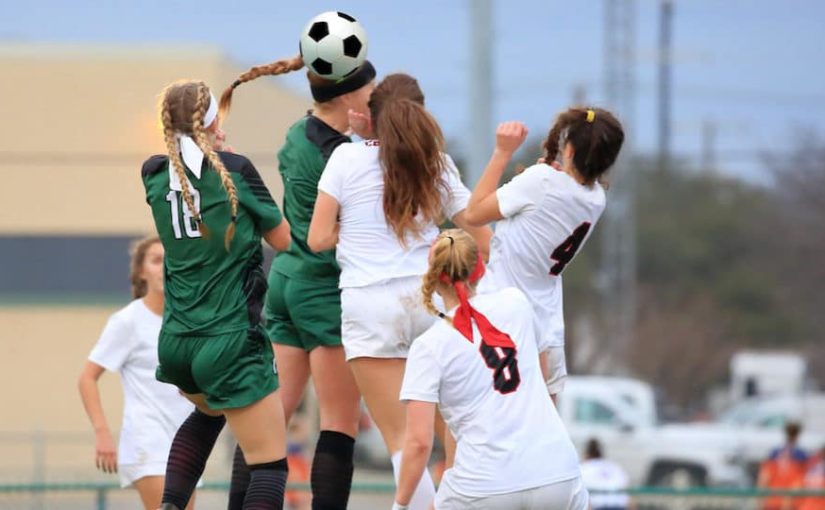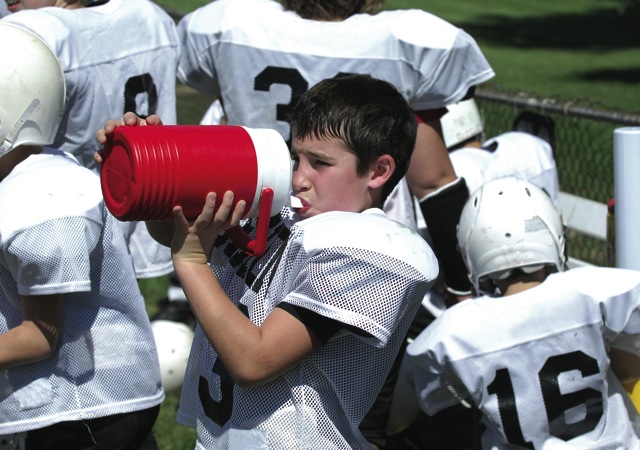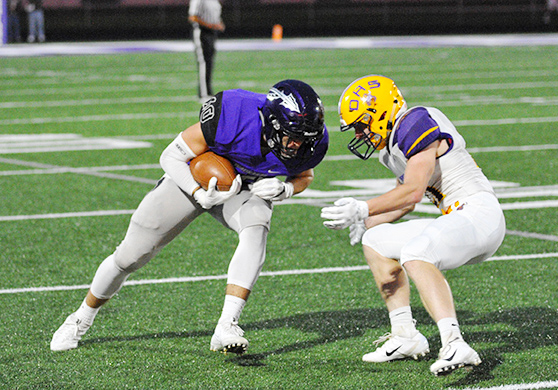SportsMed: The science of hydration
The total water content of the human body, which is composed primarily of water, is tightly regulated. The size of the body’s cells must remain relatively constant throughout activity, and the body accomplishes this through various processes of homeostasis.
The International Olympic Committee stipulates that during exercise fluid intake should prevent a dehydration rate of more than two percent body mass and yet not be so excessive as to result in weight gain. More studies need to be done to truly determine if a dehydration rate of more than two percent body mass has detrimental effects on performance. Some studies have shown a negative effect, but surprisingly, other findings have indicated an improvement in performance. More research needs to be done, especially in terms of endurance sports, where the effects of dehydration or overhydration may be accentuated over time.
Health maintenance and organ function depend on electrolyte homeostasis and water. Endurance is adversely affected by dehydration that leads to a loss of two percent of body weight. Both in the field and laboratory settings, the mental performance of athletes also appears to suffer under such dehydration, especially in hot environments. Athletic performance is also more likely to be adversely affected by dehydration in children and adolescents. The lower sweat rate, higher adiposity and lower maximal aerobic capacity in younger athletes contribute to these differences. Pediatric athletes, more than adults, have been observed to inadequately hydrate in warm conditions. More recent studies, however, have shown similar thermoregulatory responses in both adults and children when environmental conditions are held equal.1
Athletic performance is also more likely to be adversely affected by dehydration in children and adolescents. The lower sweat rate, higher adiposity and lower maximal aerobic capacity in younger athletes contribute to these differences. Pediatric athletes, more than adults, have been observed to inadequately hydrate in warm conditions. More recent studies, however, have shown similar thermoregulatory responses in both adults and children when environmental conditions are held equal.1
Observing young athletes
The hydration status of football players was assessed in one particular study, and it was found throughout the five-day examination that the players were consistently training in a state of dehydration. Hydration status was significantly improved with an acute drinking strategy of having the athletes consume 591 milliliters of sports drinks or water between dinner and sleep, and another 591 milliliters before morning training.
Similar dehydration was observed in athletes during a four-day summer sports camp study. Significant to severe dehydration was noted in about 55 percent of the athletes studied. Hydration awareness questionnaires used in this study showed that athletes knew when they were doing a poor job of hydrating, which was very interesting, considering that they were still dehydrated. This indicates that they were unable to implement successful hydration despite their knowledge about dehydration.
Another study showed that the majority of athletes going into a five-day football camp arrived already hypohydrated and became even more dehydrated during training. Subsequent performance and recovery were shown to be impaired by this study.
Minimal to moderate dehydration has been observed in football players before and after each training session. However, it appears that they do replace two-thirds of their sweat losses during training. Based on these findings, it then seems that the players practice poor hydration habits when they are not in practice.
A study involving young basketball and volleyball athletes at a training camp showed that 90 percent of them came into training inadequately hydrated. An intervention program that involved body weighing before and after practice improved water availability, and the use of a urine color chart improved hydration status in just a two-day period. Significant improvement in these athletes’ endurance performance was also noted.
More research needs to be undertaken concerning hydration in pediatric athletes. Dehydration is very common in warm environments and especially among young athletes. Successful hydration strategies do not necessarily follow from knowing about the importance of hydration. More practical interventions may be needed.
As far as endurance sports, there has been a growing body of evidence that points to drinking according to thirst as the appropriate means of addressing athletic water needs.
Hydration history
Dr. Tim Noakes references the evolutionary history of man and classifies early humans coming out of eastern and southern Africa as “long distance persistence hunters.” He purports that within this evolutionary tale lies the origin of our ability to regulate our body temperature during exercise in dry heat, even with marked dehydration. He states that no other mammal has this same ability.
Noakes contends that moment-to-moment rehydration is unnecessary in humans, who have evolved to be “delayed drinkers.” Electrolyte and fluid deficits generated during exercise are quite simply corrected by a human during their next meal. More recent evidence appears to show that fluid deficits developed during exercise or even at rest need not be completely replaced as they develop. This body of evidence indicates that drinking to the dictates of thirst is a good strategy to optimize hydration.
There is also evidence that overhydration, a possible consequence of the effective decades-long marketing strategies for sports drinks, can be in fact more dangerous than dehydration. Mental and athletic performance may be impaired by even a two-percent increase in total body water. Direr consequences can also arise from small increases in total body water as even a slight increase over two percent can result in coma, seizures, confusion and death from respiratory arrest.2
Thirst arises from receptors in the hypothalamus that detect an elevation in blood sodium concentration brought about by sweating. The acceptable range of hydration is thereby maintained by the hypothalamus through the stimulation of behavioral and hormonal changes. Thirst and water-seeking constitute these behavioral changes.
Water and sodium conservation mechanisms arise from the hormonal changes. During exercise, continued water loss through sweating is controlled by the decreased exercise intensity that accompanies the increasing sensation of thirst. Once blood osmolality returns to baseline levels as a result of these various mechanisms, the thirst sensation ceases, which in turn prevents overdrinking.
Overdrinking is not a behavior that is perpetrated by any biological system. The release of antidiuretic hormone (ADH) decreases with falling blood osmolality levels brought about by overdrinking. However, it is thought that the ADH secretion continues in overhydrated athletes who develop brain problems from low sodium, as these athletes continue to be thirsty and retain fluid even as their overhydrated state worsens.3
When enough fluid is available, the risk of dehydration to any athlete is almost non-existent provided he or she listens to the dictates of thirst. A reduction of about 15 percent of total body water is the level at which paralysis and voluntary muscle inhibition have occurred. This is the condition of individuals in the desert for more than 48 hours without water. As such, “dehydration-induced heat illness” has been shown to be quite unlikely to occur in any event where athletes have access to fluids whenever they are thirsty. People who collapse during endurance events have been shown to be no more dehydrated or warmer that control runners who completed the same races without collapsing.
Dehydration has also not been shown to be the cause of heatstroke. The body temperature of athletes is only indirectly affected by hydration with exercise intensity being the main determinant. Body temperature tends to increase with exercise intensity. When forced to exercise without adequate fluid replacement, humans can raise their body temperatures through “adaptive heterothermy.”
In such situations, the body tends to sweat less as the higher body temperature makes it easier for the body to dissipate its heat via convection to the much cooler environment. The greater the difference in temperatures, the faster the body can conduct this process. This lessens the need to sweat, and thus serves to conserve body water. The most common cause of collapse after exercise is exercise-associated postural hypotension — not dehydration — as many health care providers covering sports events are prone to assume. Exercise-associated postural hypotension is a form of vasovagal fainting that occurs in susceptible individuals within seconds or minutes after exercise. The treatment is simply to put the athlete’s head down in the Trendelenburg position.
In athletes completing endurance events, clinical signs of dehydration are unreliable in detecting substantial fluid loss. Simply eating and drinking normally has been found to be enough to replace fluid needs in mildly dehydrated athletes who finish exercise with thirst. Studies show that in athletes who are not thirsty, signs and symptoms reported after exertion are unlikely to be due to dehydration. On the other hand, overhydration manifests with clear signs and symptoms brought about by changes in cerebral function: mild withdrawal, confusion, seizures, and even the possibility of coma.
The severity of fluid overload is indirectly proportional to blood sodium levels detected in testing. Saline infusions and fluid restriction are important in the treatment of overhydrated athletes. Those with exercise-associated hyponatremic encephalopathy (damage to the brain due to low sodium levels in the blood) recover quickly from these symptoms, as rapid diuresis ensues along with the reversal of confusion in the affected athlete.
The brain can swell with overhydration; therefore intravenous mannitol and diuretics become important for athletes shown to have marked overhydration and brain swelling. Respiratory arrest may occur if this brain swelling is not reversed.
In term of hydration for athletes, dehydration and overhydration are two ends of a spectrum that will need to be continually scrutinized. This situation speaks to the challenges of caring for athletes, and the constant need for awareness regarding measures that bring about top performance and those that may lead to peril.
SportsMed appears regularly in Coach & Athletic Director magazine, offering tips on athlete health and injury prevention.
References
- 1. Kavouras, S.A., & Arnaoutis, G. (2012). Hydration status in active youth. Nutrition Today. 47(4S), 11-13.
- 2. Noakes T.D. (2012) Waterlogged: the serious problem of overhydration in endurance sports. Human Kinetics.
- 3. Noakes T.D., Sharwood, K., Speedy, D., Hew, T., Reid, S., Dugas, J., et al. (2005). Three independent biological mechanisms cause exercise-associated hyponatremia: evidence from 2135 weighed competitive athletic performances. Proceedings of the National Academy of Science, 102, 18550-5.





